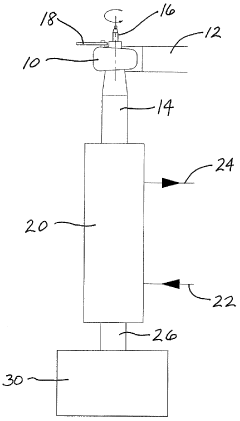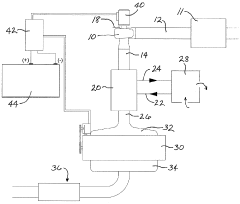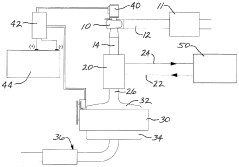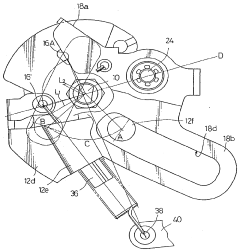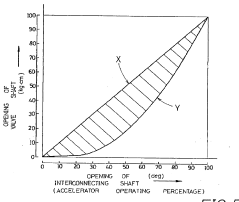Exploring Throttle Body Control in Renewable Water Technologies
JUL 18, 20259 MIN READ
Generate Your Research Report Instantly with AI Agent
Patsnap Eureka helps you evaluate technical feasibility & market potential.
Throttle Body Control Evolution and Objectives
Throttle body control has undergone significant evolution in the realm of renewable water technologies, reflecting the industry's growing focus on efficiency and sustainability. Initially developed for automotive applications, throttle body control systems have been adapted and refined for use in water management systems, particularly in the context of renewable energy generation and water conservation efforts.
The evolution of throttle body control in water technologies can be traced back to the early 2000s when researchers began exploring ways to optimize water flow in hydroelectric power plants. These early systems were rudimentary, often relying on manual adjustments and basic feedback mechanisms. As digital control systems advanced, more sophisticated throttle body control solutions emerged, incorporating sensors, actuators, and microprocessors to achieve precise water flow regulation.
A major milestone in this evolution occurred around 2010 with the integration of adaptive control algorithms. These algorithms allowed throttle body systems to dynamically adjust to changing environmental conditions and water demand, significantly improving overall system efficiency. This advancement paved the way for the development of smart water grids and more responsive renewable energy systems.
In recent years, the focus has shifted towards the miniaturization and modularization of throttle body control systems. This trend has enabled their application in smaller-scale renewable water technologies, such as micro-hydro systems and advanced irrigation networks. The incorporation of Internet of Things (IoT) capabilities has further enhanced these systems, allowing for remote monitoring and control, predictive maintenance, and integration with broader smart city initiatives.
The primary objectives of current throttle body control research in renewable water technologies are multifaceted. Firstly, there is a strong emphasis on improving energy efficiency, aiming to maximize power generation from available water resources while minimizing waste. This includes developing more precise control mechanisms and optimizing flow patterns to extract the maximum potential energy from water systems.
Secondly, researchers are focusing on enhancing the adaptability and resilience of these control systems. This involves developing algorithms that can quickly respond to sudden changes in water availability, demand fluctuations, and potential system failures. The goal is to create robust systems that can maintain optimal performance under a wide range of conditions, from drought to flood scenarios.
Another key objective is the integration of throttle body control with other renewable energy sources and storage systems. This aims to create more holistic and flexible energy management solutions, capable of balancing water-based power generation with other renewable sources like solar and wind. Such integration is crucial for developing stable and reliable renewable energy grids.
Lastly, there is a growing focus on sustainability and environmental impact. Researchers are exploring ways to design throttle body control systems that minimize ecological disruption, particularly in sensitive aquatic ecosystems. This includes developing technologies that can maintain minimum environmental flows and protect aquatic habitats while still meeting energy production goals.
The evolution of throttle body control in water technologies can be traced back to the early 2000s when researchers began exploring ways to optimize water flow in hydroelectric power plants. These early systems were rudimentary, often relying on manual adjustments and basic feedback mechanisms. As digital control systems advanced, more sophisticated throttle body control solutions emerged, incorporating sensors, actuators, and microprocessors to achieve precise water flow regulation.
A major milestone in this evolution occurred around 2010 with the integration of adaptive control algorithms. These algorithms allowed throttle body systems to dynamically adjust to changing environmental conditions and water demand, significantly improving overall system efficiency. This advancement paved the way for the development of smart water grids and more responsive renewable energy systems.
In recent years, the focus has shifted towards the miniaturization and modularization of throttle body control systems. This trend has enabled their application in smaller-scale renewable water technologies, such as micro-hydro systems and advanced irrigation networks. The incorporation of Internet of Things (IoT) capabilities has further enhanced these systems, allowing for remote monitoring and control, predictive maintenance, and integration with broader smart city initiatives.
The primary objectives of current throttle body control research in renewable water technologies are multifaceted. Firstly, there is a strong emphasis on improving energy efficiency, aiming to maximize power generation from available water resources while minimizing waste. This includes developing more precise control mechanisms and optimizing flow patterns to extract the maximum potential energy from water systems.
Secondly, researchers are focusing on enhancing the adaptability and resilience of these control systems. This involves developing algorithms that can quickly respond to sudden changes in water availability, demand fluctuations, and potential system failures. The goal is to create robust systems that can maintain optimal performance under a wide range of conditions, from drought to flood scenarios.
Another key objective is the integration of throttle body control with other renewable energy sources and storage systems. This aims to create more holistic and flexible energy management solutions, capable of balancing water-based power generation with other renewable sources like solar and wind. Such integration is crucial for developing stable and reliable renewable energy grids.
Lastly, there is a growing focus on sustainability and environmental impact. Researchers are exploring ways to design throttle body control systems that minimize ecological disruption, particularly in sensitive aquatic ecosystems. This includes developing technologies that can maintain minimum environmental flows and protect aquatic habitats while still meeting energy production goals.
Market Analysis for Renewable Water Tech
The renewable water technology market has been experiencing significant growth in recent years, driven by increasing global water scarcity and the need for sustainable water management solutions. The throttle body control technology, traditionally associated with automotive applications, has found innovative uses in water treatment and distribution systems, contributing to the overall expansion of the renewable water sector.
Market demand for renewable water technologies is primarily fueled by urbanization, population growth, and climate change impacts on water resources. Governments and industries worldwide are investing in advanced water treatment and recycling systems to address these challenges. The global water and wastewater treatment market is projected to reach substantial growth in the coming years, with a significant portion attributed to renewable and sustainable technologies.
In the context of throttle body control applications in renewable water technologies, the market shows promising potential. This technology enables precise flow control and efficient distribution of water resources, making it particularly valuable in smart water management systems. The integration of throttle body control in water treatment plants, irrigation systems, and municipal water networks has led to improved water conservation and energy efficiency.
The market for throttle body control in renewable water technologies spans across various sectors, including agriculture, industrial processes, and municipal water management. In agriculture, precision irrigation systems utilizing throttle body control mechanisms have gained traction, allowing farmers to optimize water usage and increase crop yields. Industrial applications include wastewater treatment plants and process water management, where accurate flow control is crucial for efficient operations.
Geographically, North America and Europe currently lead the market for advanced water technologies, including those incorporating throttle body control. However, rapid industrialization and urbanization in Asia-Pacific regions, particularly in countries like China and India, are creating substantial market opportunities. These emerging economies are investing heavily in water infrastructure and adopting innovative technologies to address their growing water demands.
The market landscape for throttle body control in renewable water technologies is characterized by a mix of established industrial automation companies and specialized water technology firms. Key players are focusing on developing smart, IoT-enabled throttle body control systems that can integrate seamlessly with existing water management infrastructure. This trend aligns with the broader movement towards digital water solutions and smart city initiatives.
As environmental regulations become more stringent and water scarcity issues intensify, the demand for efficient water management technologies is expected to surge. This presents a favorable market outlook for throttle body control applications in the renewable water sector. The technology's ability to enhance water distribution efficiency, reduce waste, and optimize energy consumption positions it as a valuable component in sustainable water management strategies.
Market demand for renewable water technologies is primarily fueled by urbanization, population growth, and climate change impacts on water resources. Governments and industries worldwide are investing in advanced water treatment and recycling systems to address these challenges. The global water and wastewater treatment market is projected to reach substantial growth in the coming years, with a significant portion attributed to renewable and sustainable technologies.
In the context of throttle body control applications in renewable water technologies, the market shows promising potential. This technology enables precise flow control and efficient distribution of water resources, making it particularly valuable in smart water management systems. The integration of throttle body control in water treatment plants, irrigation systems, and municipal water networks has led to improved water conservation and energy efficiency.
The market for throttle body control in renewable water technologies spans across various sectors, including agriculture, industrial processes, and municipal water management. In agriculture, precision irrigation systems utilizing throttle body control mechanisms have gained traction, allowing farmers to optimize water usage and increase crop yields. Industrial applications include wastewater treatment plants and process water management, where accurate flow control is crucial for efficient operations.
Geographically, North America and Europe currently lead the market for advanced water technologies, including those incorporating throttle body control. However, rapid industrialization and urbanization in Asia-Pacific regions, particularly in countries like China and India, are creating substantial market opportunities. These emerging economies are investing heavily in water infrastructure and adopting innovative technologies to address their growing water demands.
The market landscape for throttle body control in renewable water technologies is characterized by a mix of established industrial automation companies and specialized water technology firms. Key players are focusing on developing smart, IoT-enabled throttle body control systems that can integrate seamlessly with existing water management infrastructure. This trend aligns with the broader movement towards digital water solutions and smart city initiatives.
As environmental regulations become more stringent and water scarcity issues intensify, the demand for efficient water management technologies is expected to surge. This presents a favorable market outlook for throttle body control applications in the renewable water sector. The technology's ability to enhance water distribution efficiency, reduce waste, and optimize energy consumption positions it as a valuable component in sustainable water management strategies.
Current Challenges in Throttle Body Control
Throttle body control in renewable water technologies faces several significant challenges that hinder its widespread adoption and optimal performance. One of the primary issues is the complexity of accurately regulating water flow in diverse environmental conditions. Renewable water systems often operate in varying climates and terrains, making it difficult to maintain consistent control over the throttle body.
The integration of advanced sensors and actuators presents another hurdle. While these components are crucial for precise control, their implementation in water-based systems poses unique difficulties. Waterproofing and long-term reliability of electronic components in potentially corrosive or high-pressure environments remain ongoing concerns for engineers and designers.
Energy efficiency is a critical factor in renewable water technologies, and throttle body control plays a vital role in this aspect. However, achieving the right balance between responsive control and energy conservation is challenging. Systems that are too reactive may consume excessive power, while those that are too conservative may not respond adequately to changing demands or environmental conditions.
Scalability is another significant challenge in throttle body control for renewable water technologies. As these systems are implemented in various scales, from small residential units to large industrial applications, maintaining consistent performance and control across different sizes and capacities becomes increasingly complex. This scalability issue often requires custom solutions, which can increase costs and complicate standardization efforts.
The need for real-time adaptive control algorithms presents yet another challenge. Water flow dynamics can change rapidly due to factors such as pressure fluctuations, temperature variations, and system wear. Developing algorithms that can quickly and accurately respond to these changes while maintaining system stability is a complex task that requires ongoing research and development.
Maintenance and durability of throttle body components in water-based systems also pose significant challenges. Exposure to water, minerals, and potential contaminants can lead to wear, corrosion, and reduced performance over time. Designing throttle bodies that can withstand these conditions while maintaining precise control capabilities is an ongoing engineering challenge.
Lastly, the integration of throttle body control systems with other renewable water technologies and smart water management systems presents interoperability challenges. Ensuring seamless communication and coordination between various components and subsystems is crucial for optimal performance but requires overcoming compatibility issues and establishing standardized protocols.
The integration of advanced sensors and actuators presents another hurdle. While these components are crucial for precise control, their implementation in water-based systems poses unique difficulties. Waterproofing and long-term reliability of electronic components in potentially corrosive or high-pressure environments remain ongoing concerns for engineers and designers.
Energy efficiency is a critical factor in renewable water technologies, and throttle body control plays a vital role in this aspect. However, achieving the right balance between responsive control and energy conservation is challenging. Systems that are too reactive may consume excessive power, while those that are too conservative may not respond adequately to changing demands or environmental conditions.
Scalability is another significant challenge in throttle body control for renewable water technologies. As these systems are implemented in various scales, from small residential units to large industrial applications, maintaining consistent performance and control across different sizes and capacities becomes increasingly complex. This scalability issue often requires custom solutions, which can increase costs and complicate standardization efforts.
The need for real-time adaptive control algorithms presents yet another challenge. Water flow dynamics can change rapidly due to factors such as pressure fluctuations, temperature variations, and system wear. Developing algorithms that can quickly and accurately respond to these changes while maintaining system stability is a complex task that requires ongoing research and development.
Maintenance and durability of throttle body components in water-based systems also pose significant challenges. Exposure to water, minerals, and potential contaminants can lead to wear, corrosion, and reduced performance over time. Designing throttle bodies that can withstand these conditions while maintaining precise control capabilities is an ongoing engineering challenge.
Lastly, the integration of throttle body control systems with other renewable water technologies and smart water management systems presents interoperability challenges. Ensuring seamless communication and coordination between various components and subsystems is crucial for optimal performance but requires overcoming compatibility issues and establishing standardized protocols.
Existing Throttle Body Control Solutions
01 Electronic throttle control systems
Electronic throttle control systems are used to regulate the airflow into an engine's combustion chamber. These systems typically include sensors, a control unit, and an actuator to adjust the throttle plate position based on various inputs such as accelerator pedal position and engine operating conditions.- Electronic throttle control systems: Electronic throttle control systems are used to regulate the airflow into an engine's combustion chamber. These systems typically include sensors, actuators, and control units to manage the throttle position based on various inputs such as accelerator pedal position and engine operating conditions.
- Throttle body design and components: Throttle body design focuses on optimizing airflow and control. Key components include the throttle plate, housing, and associated sensors. Innovations in this area aim to improve response time, reduce friction, and enhance overall engine performance.
- Throttle position sensors and feedback mechanisms: Accurate throttle position sensing is crucial for precise control. Advanced sensors and feedback mechanisms are employed to monitor throttle plate position and movement, enabling real-time adjustments and improved engine management.
- Throttle control algorithms and software: Sophisticated control algorithms and software are developed to optimize throttle response and engine performance. These systems take into account various parameters such as engine speed, load, and environmental conditions to adjust throttle position dynamically.
- Integration with engine management systems: Throttle control is increasingly integrated with broader engine management systems. This integration allows for improved coordination between throttle position, fuel injection, ignition timing, and other engine functions, resulting in enhanced overall performance and efficiency.
02 Throttle body design and components
Throttle body design focuses on optimizing airflow and control. Key components include the throttle plate, housing, and various sensors. Innovations in this area aim to improve response time, reduce friction, and enhance overall engine performance.Expand Specific Solutions03 Throttle position sensors and feedback mechanisms
Accurate throttle position sensing is crucial for precise engine control. Advanced sensors and feedback mechanisms are employed to monitor throttle plate position and movement, enabling real-time adjustments and improved engine management.Expand Specific Solutions04 Throttle control algorithms and software
Sophisticated control algorithms and software are developed to optimize throttle response and engine performance. These systems take into account various parameters such as engine load, speed, and environmental conditions to adjust throttle position dynamically.Expand Specific Solutions05 Integration with engine management systems
Throttle control is increasingly integrated with broader engine management systems. This integration allows for more comprehensive control of engine performance, fuel efficiency, and emissions by coordinating throttle adjustments with other engine subsystems.Expand Specific Solutions
Key Players in Renewable Water Industry
The throttle body control technology in renewable water technologies is in an early development stage, with a growing market driven by increasing focus on sustainable water management. The market size is expanding as more industries adopt water-efficient solutions. Technologically, it's still evolving, with companies like Honeywell International Technologies, SAMSON AG, and Baker Hughes Co. leading innovation. These firms are developing advanced control systems to optimize water flow and usage in various applications. While the technology shows promise, it's not yet fully mature, indicating significant potential for further advancements and market growth in the coming years.
Honeywell International Technologies Ltd.
Technical Solution: Honeywell has pioneered a smart throttle body control system for renewable water technologies, leveraging their expertise in industrial automation. Their solution incorporates advanced sensors and machine learning algorithms to predict water demand patterns and adjust throttle positions proactively[2]. Honeywell's system integrates with their broader building management solutions, allowing for holistic water resource optimization in smart buildings and industrial facilities[4]. The company has also developed specialized coatings for throttle body components, enhancing durability and reducing maintenance requirements in harsh water environments[6]. Honeywell's throttle control units feature redundant fail-safe mechanisms, ensuring continuous operation even in the event of component failure[8].
Strengths: Predictive control capabilities, integration with broader management systems, and enhanced durability. Weaknesses: May require significant infrastructure changes for full benefit realization.
SAMSON AG
Technical Solution: SAMSON AG has developed a highly specialized throttle body control system for renewable water technologies, focusing on precision and reliability in industrial applications. Their solution utilizes advanced materials such as ceramic-coated throttle plates to resist corrosion and scaling in diverse water qualities[1]. SAMSON's throttle bodies incorporate self-diagnostic capabilities, continuously monitoring performance and predicting maintenance needs[3]. The company has also implemented a modular design approach, allowing for easy customization and upgrades to meet specific application requirements[5]. SAMSON's control systems feature adaptive PID algorithms that automatically tune throttle response based on changing system dynamics, ensuring optimal performance across various operating conditions[7].
Strengths: Corrosion-resistant design, predictive maintenance capabilities, and adaptability to different applications. Weaknesses: Potentially higher cost due to specialized materials and advanced features.
Innovative Throttle Body Control Patents
Fluid flow control system having a moving fluid expander providing flow control and conversion of fluid energy into other useful energy forms
PatentWO2011005616A2
Innovation
- A moving fluid expander with a variable expansion ratio and speed control replaces conventional throttles, converting fluid energy into usable forms by expanding the fluid and optionally using a heat exchanger to manage temperature, thereby reducing energy loss and achieving flow control.
Throttle body having interconnecting lever for converting an operational amount of accelerator to an opening of throttle valve
PatentInactiveUS4945874A
Innovation
- Incorporating a tension spring to stabilize the throttle valve, using a spiral spring for consistent force, and an eccentric mounting member for cam follower adjustment, along with separating the interconnecting lever into two parts to decouple auto speed control from the accelerator pedal, ensuring smooth operation and fine adjustment capabilities.
Environmental Impact Assessment
The environmental impact assessment of throttle body control in renewable water technologies reveals both positive and negative effects on ecosystems and natural resources. On the positive side, the implementation of advanced throttle body control systems in water management can lead to significant improvements in water conservation and energy efficiency. By precisely regulating water flow and pressure, these systems can reduce water waste and minimize the energy required for pumping and distribution.
Furthermore, the optimization of water usage through throttle body control can help preserve aquatic ecosystems by maintaining more stable water levels in rivers and reservoirs. This stability is crucial for protecting fish populations and other aquatic life, as well as maintaining the overall health of riparian habitats. The reduced energy consumption associated with improved water management also contributes to lower greenhouse gas emissions, aligning with global efforts to combat climate change.
However, the environmental assessment also highlights potential negative impacts that must be considered. The production and installation of throttle body control systems involve the use of materials and manufacturing processes that may have their own environmental footprint. This includes the extraction of raw materials, energy consumption during production, and potential electronic waste at the end of the system's lifecycle.
Additionally, the increased reliance on electronic control systems in water management introduces new vulnerabilities to cyber threats and system failures. Such incidents could potentially lead to water supply disruptions or uncontrolled releases, which may have severe environmental consequences if not properly mitigated.
The assessment also considers the long-term effects of altering natural water flow patterns. While throttle body control can optimize water usage, it may also disrupt the natural hydrological cycles that some ecosystems have adapted to over time. This could potentially affect sediment transport, nutrient distribution, and the migration patterns of aquatic species.
To address these concerns, the environmental impact assessment recommends implementing comprehensive monitoring systems to track the effects of throttle body control on local ecosystems. It also suggests developing robust fail-safe mechanisms and cybersecurity protocols to prevent system failures and unauthorized access. Furthermore, the assessment emphasizes the importance of conducting site-specific studies to understand the unique environmental dynamics of each implementation area and tailor the throttle body control systems accordingly.
Furthermore, the optimization of water usage through throttle body control can help preserve aquatic ecosystems by maintaining more stable water levels in rivers and reservoirs. This stability is crucial for protecting fish populations and other aquatic life, as well as maintaining the overall health of riparian habitats. The reduced energy consumption associated with improved water management also contributes to lower greenhouse gas emissions, aligning with global efforts to combat climate change.
However, the environmental assessment also highlights potential negative impacts that must be considered. The production and installation of throttle body control systems involve the use of materials and manufacturing processes that may have their own environmental footprint. This includes the extraction of raw materials, energy consumption during production, and potential electronic waste at the end of the system's lifecycle.
Additionally, the increased reliance on electronic control systems in water management introduces new vulnerabilities to cyber threats and system failures. Such incidents could potentially lead to water supply disruptions or uncontrolled releases, which may have severe environmental consequences if not properly mitigated.
The assessment also considers the long-term effects of altering natural water flow patterns. While throttle body control can optimize water usage, it may also disrupt the natural hydrological cycles that some ecosystems have adapted to over time. This could potentially affect sediment transport, nutrient distribution, and the migration patterns of aquatic species.
To address these concerns, the environmental impact assessment recommends implementing comprehensive monitoring systems to track the effects of throttle body control on local ecosystems. It also suggests developing robust fail-safe mechanisms and cybersecurity protocols to prevent system failures and unauthorized access. Furthermore, the assessment emphasizes the importance of conducting site-specific studies to understand the unique environmental dynamics of each implementation area and tailor the throttle body control systems accordingly.
Regulatory Framework for Water Tech
The regulatory framework for water technology plays a crucial role in shaping the development and implementation of innovative solutions in the renewable water sector. As throttle body control becomes increasingly important in water management systems, it is essential to understand the existing regulations and potential future changes that may impact this technology.
Current regulations in many jurisdictions focus on water quality standards, conservation measures, and efficiency requirements. These regulations often set limits on water usage, mandate the implementation of water-saving technologies, and establish guidelines for water treatment and distribution. However, specific regulations addressing throttle body control in renewable water technologies are still evolving.
In the United States, the Environmental Protection Agency (EPA) oversees water regulations at the federal level, while state and local governments may impose additional requirements. The Clean Water Act and Safe Drinking Water Act provide the foundation for many water-related regulations. As throttle body control technology advances, it is likely that these regulations will be updated to incorporate new standards and guidelines.
The European Union has established the Water Framework Directive, which aims to achieve good ecological and chemical status for all water bodies. This directive, along with other EU water policies, may influence the development and adoption of throttle body control technologies in renewable water systems across member states.
Emerging economies, such as China and India, are also implementing stricter water regulations to address growing concerns about water scarcity and pollution. These countries are likely to introduce new policies that could impact the use of throttle body control in water management systems.
As the importance of water conservation and efficient management grows, it is anticipated that regulatory bodies will introduce more specific guidelines for throttle body control in renewable water technologies. These regulations may focus on aspects such as energy efficiency, precision control, and integration with smart water management systems.
Compliance with existing and future regulations will be crucial for companies developing and implementing throttle body control technologies in the water sector. Staying informed about regulatory changes and actively participating in industry discussions can help organizations adapt their technologies to meet evolving requirements and capitalize on new opportunities in the renewable water market.
Current regulations in many jurisdictions focus on water quality standards, conservation measures, and efficiency requirements. These regulations often set limits on water usage, mandate the implementation of water-saving technologies, and establish guidelines for water treatment and distribution. However, specific regulations addressing throttle body control in renewable water technologies are still evolving.
In the United States, the Environmental Protection Agency (EPA) oversees water regulations at the federal level, while state and local governments may impose additional requirements. The Clean Water Act and Safe Drinking Water Act provide the foundation for many water-related regulations. As throttle body control technology advances, it is likely that these regulations will be updated to incorporate new standards and guidelines.
The European Union has established the Water Framework Directive, which aims to achieve good ecological and chemical status for all water bodies. This directive, along with other EU water policies, may influence the development and adoption of throttle body control technologies in renewable water systems across member states.
Emerging economies, such as China and India, are also implementing stricter water regulations to address growing concerns about water scarcity and pollution. These countries are likely to introduce new policies that could impact the use of throttle body control in water management systems.
As the importance of water conservation and efficient management grows, it is anticipated that regulatory bodies will introduce more specific guidelines for throttle body control in renewable water technologies. These regulations may focus on aspects such as energy efficiency, precision control, and integration with smart water management systems.
Compliance with existing and future regulations will be crucial for companies developing and implementing throttle body control technologies in the water sector. Staying informed about regulatory changes and actively participating in industry discussions can help organizations adapt their technologies to meet evolving requirements and capitalize on new opportunities in the renewable water market.
Unlock deeper insights with Patsnap Eureka Quick Research — get a full tech report to explore trends and direct your research. Try now!
Generate Your Research Report Instantly with AI Agent
Supercharge your innovation with Patsnap Eureka AI Agent Platform!
